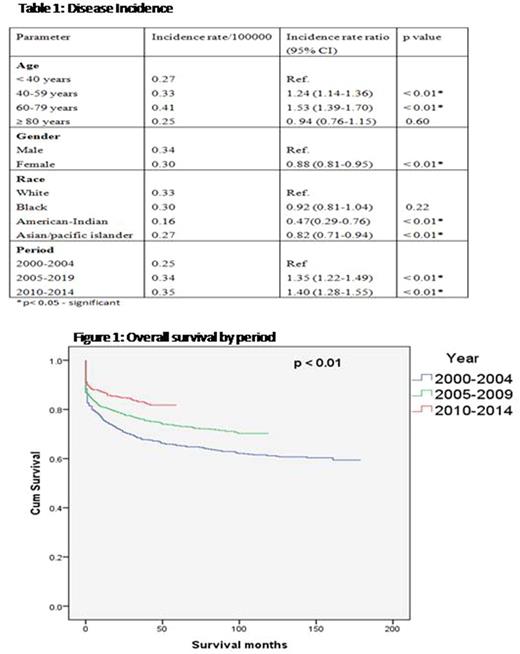Abstract
Background:
Outcomes of acute promyelocytic leukemia (APL) have significantly improved in the current era with clinical trials demonstrating excellent survival using ATRA, arsenic trioxide and chemotherapy based regimens. However, population level data on the disease incidence and survival in the last decade from United States is sparse.
Methods:
Using Surveillance Epidemiology and End Results database, we identified patients aged ≥ 20 years with pathologically confirmed APL (ICD-0-3 code 9866) as the only primary malignancy, known race, diagnosed between the years 2000-2014 and actively followed. We calculated the incidence and overall survival (OS) in this population. Incidence rate per 100000 population and incidence rate ration (IRR) were calculated to determine the relative difference in disease incidence among subgroups. Period of diagnosis was stratified into 3 groups - 2000-2004, 2005-2009, 2010-2014. Kaplan-Meier method and log rank test were used to analyze the OS among subgroups. For survival analysis, only patients who received treatment were included. Early mortality was defined by death within 30 days of diagnosis. Cox proportional hazard regression method was used to determine the influence of time and demographic factors on OS. Statistical analyses were carried out with significant two sided p< 0.05.
Results:
A total of 2367 patients with a median age of 46 years (range 20-92 years) were included. Males (51.5%) and White race (79.8%) contributed to the majority. Overall incidence of APL was 0.32 per 100000 population during the period 2000-2014.The disease incidence increased significantly with age (upto 79 years) and from the year 2005 onwards (Table 1). The disease incidence was lower in females (0.30 per 100000, p<0.01) as compared to males (0.34 per 100000) and lower in American-Indians (0.16 per 100000, p <0.01) and Asian/pacific islanders (0.27 per 100000, p< 0.01) as compared to Whites (0.33 per 100000). When stratified by the period of diagnosis, the 5-year OS was significantly higher for patients diagnosed between the year 2010-2014 (81.7%) as compared to those diagnosed from 2005-2009 (73.3%) and 2000-2004 (65.3%, p <0.001) (Figure 1). The 5-year OS was not significantly different by gender (females-75.1%, males 72.6%, p=0.18) or race (Whites-73.9%, Blacks 73.8%, Asians 72.1%, American-Indians 82.5%, p=0.85). The 5-year OS decreased with increasing age (age < 40 - 84.7%, age 40-59 -75.3%, age 60-79- 57.5%, age ≥80 -19.6%, p< 0.001). Early mortality did not significantly differ over time (year 2000-2004 - 13.2%, 2005-2009 - 11.7%, 2010-2014 - 10.1%, p=0.17). On multivariate analysis, increasing age (HR 1.04, 95% CI 1.03-1.04, p< 0.001) was associated with higher mortality. Diagnosis in the period 2005-2008 (HR 0.68, 95%CI 0.56-0.82 p<0.001) and 2010-2014 (HR 0.45, 95%CI 0.36-0.56, p< 0.001) were associated with significantly lower mortality hazard.
Conclusions:
Survival of patients with APL has continued to improve over time, however early mortality has not changed significantly. Incidence of APL varies by factors such as age, gender, race and has increased in the recent period. Age remains as an important predictor of survival even in the current era.
Guru Murthy: Janssen: Other: Fellows advisory board. Dhakal: Celgene: Honoraria. Hamadani: Celgene, Cellerant, Jansen, MedImmune: Consultancy; Sanofi Genzyme: Research Funding, Speakers Bureau; Takeda, Otsuka, MedImmune, Merck, ADC Therapeutics: Research Funding. Michaelis: Celgene: Speakers Bureau; Novartis: Other: Consultation for New Product; Incyte: Other: consultation for product. Atallah: ADC Therapeutics: Research Funding.
Author notes
Asterisk with author names denotes non-ASH members.


